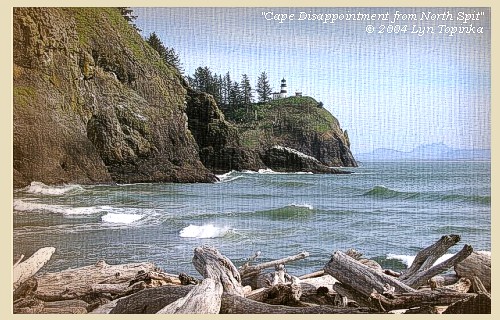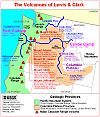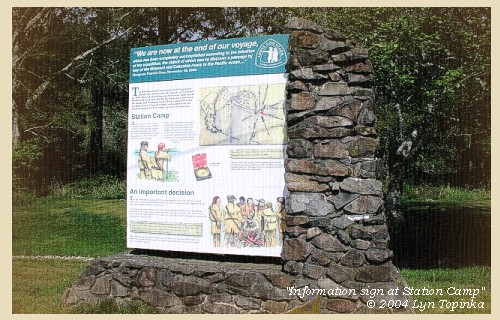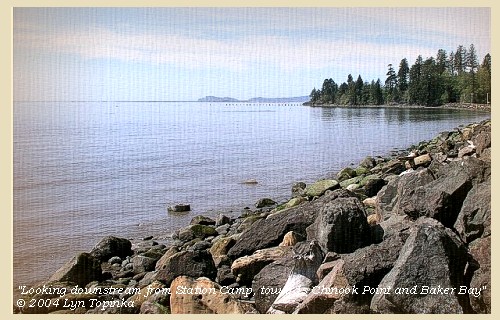
Cape Disappointment:
Cape Disappointment, the rugged north point
at the Columbia River entrance, is the first major
headland along the 20 miles of sand beach north
from Tillamook Head. It comprises a group of
rounding hills covering an area 2.5 miles long
and one mile wide, divided by a narrow valley
extending north-northwest. The seaward faces of
these hills are precipitous cliffs with jagged,
rocky points and small strips of sand beach.
Lewis and Clark used the British
geographical place names given by Captain John
Meares, a British trading merchant,
to describe the headlands at the mouth of the
Columbia.
In 1788 Meares was disappointed at not finding "The River of the
West". When he saw the mouth of the Columbia River,
he thought it was only an entrance to a bay --
thus the name Cape Disappointment.
Cape Disappointment is one of
the oldest British geographical place names in
Washington.
-- NOAA Office of Coast Survey Website, 2003, and
Washington State Historical Society Website, 2002
















- 1787 Map, North American Coastline around the Columbia River (section of original). (Click to enlarge).
Includes Cape Disappointment as "C. de San Roque".
Original Map:
"Carta que contiene parte de la costa de la California", by
Bernabe Munoz, 1787. Scale ca.1:5,000,000.
Library of Congress American Memory Archives #G4362.C6 1787 .M8 TIL Vault.
-- U.S. Library of Congress Archives, 2004, "American Memory"
- 1798 Map, Mouth of the Columbia River (section of original). (Click to enlarge).
Inset map of original, showing the mouth of the Columbia River, including Cape Disappointment, Point Adams, Youngs River, Point George (today's Astoria), and Grays Bay.
Original Map: George Vancouver's "A Chart Shewing Part of the
Coast of N.W. America." In A Voyage of discovery to the North Pacific ocean, and Round the World. London, 1798.
University of Virginia Special Collection "Lewis & Clark, The Maps of Exploration 1507-1814".
-- University of Virginia Library Archives Website, 2004
- 1814 Map, Lewis and Clark's map of the Columbia River (section of original). (Click to enlarge.) Shows Cape Disappointment.
Map also includes three of the five volcanoes Lewis and Clark saw and commented on. While the journals mention the expedition seeing Mount Adams, it does not appear on their map. Mount Jefferson is to the south (bottom) and off the map.
From the "Nicholas Biddle/Paul Allen" 1814 publication.
Original Map: "A Map of Lewis and Clark's Track, Across the Western Portion of North America, From the Mississippi to the Pacific Ocean".
From: History of the expedition under the command of Captains Lewis and Clark : to the sources of the Missouri, thence across the Rocky Mountains and down the river Columbia to the Pacific Ocean : performed during the years 1804-5-6 : by order of the government of the United States / prepared for the press by Paul Allen. Philadelphia : Bradford and Insskeep, 1814.
Harold B. Lee Library, Brigham Young University #upbover maps37.
-- Brigham Young University, Harold B. Lee Library Website, 2004.
- 1849 Map (section of original), Alexander Ross's Columbia River. (Click to enlarge).
Original Map: Map of the Columbia to illustrate Ross's adventures.
Author: Alexander Ross; Publication Date: 1849; Publisher: London, Smith, Elder and Co., 1849.
Washington State University Archives #WSU478.
-- Washington State University Early Washington Maps Digital Collection Website, 2004
- 1851 Map, Cape Disappointment, Washington (section of original). (Click to enlarge).
Cape Disappointment was also known as Cape Hancock.
Original Map: "Mouth of the Columbia River, Preliminary Survey, 1851".
U.S. Coast Survey, 1851, #640, Scale 1:40,000.
U.S. Office of Coast Survey Historical Map and Chart Collection #2228148.
-- NOAA Archives Website, 2004
- 1853 Map, Washington and Oregon and the Columbia River,
from the Clearwater River to the Snake River and down the Columbia River to the Pacific Ocean (section of original). (Click to enlarge).
Includes: Clearwater River (Kooskooski), Lapwai Creek (Lapwai R.), Snake River (Saptin or Lewis R.), Columbia River (Columbia R.), Yakima River (Yakima R.), Walla Walla River (Wallawalla R.), Umatilla River (Umatilla R.), Willow Creek (Quesnells R.), John Day River (John day's R.), Deschutes River (Fall R.), Willamette River (Willammette R.), and Cowlitz River (Cowlitz R.).
Original Map: "Map of California, Oregon, Washington, Utah, and New Mexico (1853)",
by Thomas Cowperthwait & Co.
Washington State University Archives #WSU22.
-- Washington State University Library Collections Website, 2003
- 1855 Map, Mouth of the Columbia River, with Cape Disappointment and Long Beach Peninsula (section of original). (Click to enlarge). Original Map: "Map of a part of the Territory of Washington : to accompany report of Surveyor General (1855)".
By James Tilton, Washington (State) Surveyor General's Office.
Relief shown by hachures, Scale 1:1,140,480.
Washington State University Historical Maps Collection #WSU314, and
University of Washington Map Collection #UW114.
-- Washington State University Library Archives Website, 2004
- 1855 Map, Northwest Oregon and mouth of the Columbia River (section of original). (Click to enlarge).
Includes the Columbia River, Cape Disappointment, Point Adams, Saddle Mountain, Lewis and Clark River, Youngs River.
Original Map:
From the northern boundary of California to the Columbia River : from explorations and surveys / made under the direction of Hon. Jefferson Davis, Sec. of War by Lieut. R. S. Williamson, U.S. Topl. Engrs. and Lieut. H. L. Abbot, U.S. Topl. Engrs., H. C. Fillebrown, J. Young, and C. D. Anderson, Assts., 1855.
Notes: Scale 1:760,320.
Relief shown by hachures.
At head of title: Routes in Oregon and California. Map no. 2.
"Drawn by John Young."
From U.S. War Department, Explorations and Surveys for a Railroad Route from the Mississippi River to the Pacific Ocean. Topographical Maps... to Illustrate the Various Reports... (Washington, 1859)
Library of Congress American Memory Archives #G4290 1855 .W5 RR 170.
-- U.S. Library of Congress Archives, 2004, "American Memory"
- 1887 Map, Columbia River from the Mouth to Pillar Rock (section of original). (Click to enlarge).
Cape Disappointment is shown as Cape Hancock.
Original Map: The Columbia River from Celilo to the mouth showing locations of the salmon fisheries, 1887.
Scale ca. 1:375,000, Relief shown by hachures.
U.S. Army Corps of Engineers, Engineer Office, G.P.O. 1888.
University of Washington Archives #UW128.
-- University of Washington Library Archives Website, 2004
- 1887, Map, Cape Disappointment and Baker Bay. (Click to enlarge).
Mouth of the Columbia River showing fishtraps in Baker's Bay, 1887.
U.S. Army Corps of Engineers Map, published 1888.
University of Washington Map Archives #UW129.
-- University of Washington Library Collections Website, 2002
- 1949 Map (section of original), Cape Disappointment, North Head, McKenzie Head, Fort Canby, Ilwaco. (Click to enlarge).
Office of Coast Surveys, Historical Maps and Charts,
Columbia River, Pacific Ocean to Harrington Point, 1949, Chart#6151, 1:40,000.
-- NOAA Office of Coast Survey Website, 2004
- 1987 Map, Cape Disappointment, Ilwaco, Baker Bay (section of original). (Click to enlarge).
Office of Coast Surveys, Historical Maps and Charts,
Columbia River, Pacific Ocean to Harrington Point, 1987, Chart#18521, 1:40,000.
-- NOAA Office of Coast Survey Website, 2004
- 2001, NASA Image, Mouth of the Columbia River,
including Cape Disappointment. (Click to enlarge).
NASA Space Shuttle photograph of the mouth of the Columbia River,
including the location of Fort
Clatsop, Lewis and Clark National Wildlife Refuge,
Tenasillahe Island, Puget Island, and
Crim's Island, and others, June 20, 2001.
NASA Astronaut Photography of Earth #SS002-724-30.
-- NASA Astronaut Photography of Earth Website, 2002
- ca.1879-1909, Cape Disappointment. (Click to enlarge).
Pictured is a scene in the region served by the Oregon Railway & Navigation Company between
1879-1909. This is Cape Disappointment, north of the Columbia River.
Photographer unknown. Oregon State Archives Salem Public Library #ORN25A.
-- Oregon State Archives Website, 2003
- 1997, Aerial view, Cape Disappointment. (Click to enlarge).
Looking at Cape Disappointment Lighthouse.
Washington State Department of Ecology Shorelines Aerial Photo #PAC0547, May 10, 1997.
-- Washington State Department of Ecology Website, 2002
- 2004, Cape Disappointment, as seen from North Spit, looking towards Cape Disappointment Lighthouse. (Click to enlarge).
Copyright © 2004 Lyn Topinka, private archives, used with permission.
North Head:
North Head, the extreme western point of Cape Disappointment, is 170 feet high, with a very
jagged, precipitous cliff, backed by a narrow grassy strip. The higher ground behind it is
covered with trees. The North Head Lighthouse was built in 1898, and affords a spectacular view of the Pacific Ocean, with Benson Beach and the mouth of the Columbia River to the south and the Long
Beach Peninsula stretching northward, a panoramic vista unparalleled on a clear day.
-- NOAA Office of Coastal Survey website, 2003,
Washington State Parks and Recreation Website, 2003, and
Long Beach Area State Parks, 2002




- 1887, Map, Cape Disappointment and Baker Bay, including McKenzie Head. (Click to enlarge).
Mouth of the Columbia River showing fishtraps in Baker's Bay, 1887.
U.S. Army Corps of Engineers Map, published 1888.
University of Washington Map Archives #UW129.
-- University of Washington Library Collections Website, 2002
- 1949 Map (section of original), Cape Disappointment, North Head, McKenzie Head, Fort Canby, Ilwaco. (Click to enlarge).
Office of Coast Surveys, Historical Maps and Charts,
Columbia River, Pacific Ocean to Harrington Point, 1949, Chart#6151, 1:40,000.
-- NOAA Office of Coast Survey Website, 2004
- 1997, Aerial view, North Head showing the North Head Lighthouse. (Click to enlarge).
Washington State Department of Ecology Shorelines Aerial Photo
#PAC0533, May 10, 1997.
-- Washington State Department of Ecology Website, 2002
- 1912, North Head Lighthouse. (Click to enlarge).
Original from: "Puget Sound and Western
Washington Cities-Towns Scenery" by Robert A. Reid, Robert A. Reid Publisher,
Seattle, 1912. Archival photograph by
Steve Nicklas, NGS/RSD.
Image from the NOAA Photo Archives Coastline Collection #line2186.
-- NOAA Photo Archives Website, 2002
McKenzie Head:
McKenzie Head is located 0.8 miles northwest of Cape Disappointment Light. It is 190 feet high and nearly round. On its seaward face it is covered with grass and fern, bare of trees. On its eastern face it is heavily wooded with spruce.
-- NOAA Office of Coast Survey Website, 2003



- 1887, Map, Cape Disappointment and Baker Bay, including McKenzie Head. (Click to enlarge).
Mouth of the Columbia River showing fishtraps in Baker's Bay, 1887.
U.S. Army Corps of Engineers Map, published 1888.
University of Washington Map Archives #UW129.
-- University of Washington Library Collections Website, 2002
- 1949 Map (section of original), Cape Disappointment, North Head, McKenzie Head, Fort Canby, Ilwaco. (Click to enlarge).
Office of Coast Surveys, Historical Maps and Charts,
Columbia River, Pacific Ocean to Harrington Point, 1949, Chart#6151, 1:40,000.
-- NOAA Office of Coast Survey Website, 2004
- 1997, Aerial view, McKenzie Head. (Click to enlarge).
Washington State Department of Ecology Shorelines Aerial Photo #PAC0544, May 10, 1997.
-- Washington State Department of Ecology Website, 2002
Fort Canby:
In 1862, Cape Disappointment was armed with
smoothbore cannons to protect the mouth of the
Columbia River from enemies. The installation was
expanded to become Fort Canby in 1875. The fort
was named after General Edward Canby, who was
killed in the Modoc Indian War. The fort continued
to be improved until the end of World War II.
Gun batteries still sit uptop the park. Today Cape Disappointment State Park (formerly Fort Canby State Park) is a 1,882-acre camping park which offers
27 miles of ocean beach, two lighthouses, an interpretive center
and hiking trails. Visitors enjoy beachcombing and exploring the
area's rich natural and cultural history. The nearby coastal towns
of Ilwaco and Long Beach feature special events and festivals
spring through fall.
-- Washington State Parks and Recreation Website,
2002



- 1949 Map (section of original), Cape Disappointment, North Head, McKenzie Head, Fort Canby, Ilwaco. (Click to enlarge).
Office of Coast Surveys, Historical Maps and Charts,
Columbia River, Pacific Ocean to Harrington Point, 1949, Chart#6151, 1:40,000.
-- NOAA Office of Coast Survey Website, 2004
- 2001, NASA Image, Mouth of the Columbia River,
including Fort Canby State Park. (Click to enlarge).
NASA Space Shuttle photograph of the mouth of the Columbia River,
including the location of Fort
Clatsop, Lewis and Clark National Wildlife Refuge,
Tenasillahe Island, Puget Island, and
Crim's Island, and others, June 20, 2001.
NASA Astronaut Photography of Earth #SS002-724-30.
-- NASA Astronaut Photography of Earth Website, 2002
- 1997, Aerial view, Fort Canby State Park. (Click to enlarge).
Washington State Department of Ecology Shorelines Aerial Photo #PAC0546, May 10, 1997.
-- Washington State Department of Ecology Website, 2002
Lewis and Clark Interpretive Center:
In November of 1805, the U.S. Corps of Volunteers for Northwest Discovery,
led by Meriwether Lewis and William Clark, reached the mouth of the mighty
Columbia River and the Pacific Ocean at last. "Great joy in camp," Clark
wrote in his journal, "we are in View of the Ocian, this great Pacific Ocian
which we been So long anxious to See."
Today the Lewis and Clark Interpretive Center stands high on the cliffs of Fort
Canby State Park, 200 feet above the pounding Pacific surf. A series of
mural-sized "timeline" panels guide visitors through the westward journey of
the Lewis and Clark Expedition using sketches, paintings, photographs and
the words of Corps members themselves. The center also features short film
presentations, a gift shop and a glassed-in observation deck with fabulous
views of the river, headlands and sea.
-- Washington State Parks and Recreation Website,
2003

- 1997, Aerial view, Fort Canby State Park and the Lewis and Clark Interpretive Center. (Click to enlarge).
Washington State Department of Ecology Shorelines Aerial Photo #PAC0546, May 10, 1997.
-- Washington State Department of Ecology Website, 2002
|






























